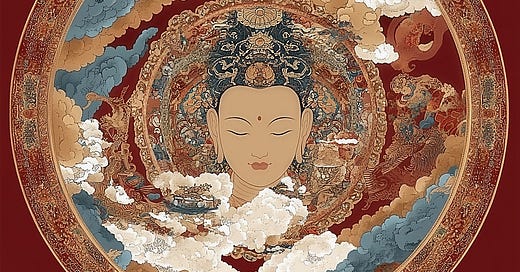It took me years to grasp the many ways that the word “mandala” is used in Vajrayana Buddhism. Literally, it means something like:
A circle with a center, exterior environment, and surrounding walls.
Spiritually and culturally, it’s much more than that, encompassing a rich tapestry (pun intended) of spiritual, ritual, and symbolic applications. A mandala serves as a tool for meditation, teaching, and transformation, deeply embedded in both religious practice and cultural expression, especially in the Tibetan community and among its many fellow travelers.
You may be familiar with mandalas painstakingly constructed by monks over weeks or months to represent a perfect universe and then destroyed to demonstrate impermanence and non-attachment. You may have seen thangkas—painted scrolls hanging on walls with mandalas depicting deities.
Some mandalas map the universe, with Mount Meru at the center and concentric circles symbolizing elements like earth, water, fire, and air, with an outer circle representing the cycle of life, death, and rebirth. Another type of mandala represents a deity’s celestial palace.
As ritual objects, mandalas are used in empowerments, visualizations, tantric transformations, purifications, and ceremonies of devotion and generosity.
Increasingly, I’ve been hearing the word used for the spiritual fabric of a community. Every morning, I meditate with a Zoom spiritual community. We see ourselves as a mandala. One of my teachers, Anam Thubten, often talks about the mandala of his students. Others might refer to the mandala of students at a retreat.
Lama Tsultrim Allione is a teacher I’ve grown to appreciate deeply since I’ve begun a yearlong studies program with her. The international Buddhist community she founded is called Tara Mandala, with a retreat center in Pagosa Springs and a worldwide mandala of students. Lama Tsultrim, who has been recognized as an emanation of Machig Labdrön, was born in New England, traveled to Asia in her late teens, and in 1970, at the age of 22, became the first American to be ordained as a Tibetan Buddhist nun.
Lama Tsultrim’s book Feeding Your Demons: Ancient Wisdom for Resolving Inner Conflict was published in 2008 and remains well-ranked among Tibetan Buddhist books on Amazon. Often guided by teachers, counselors, or therapists, many have benefited from the gentle five-step program the book offers.
One of the most accomplished women in worldwide Buddhism today, Lama Tsultrim explores the sacred feminine in Wisdom Rising: Journey into the Mandala of the Empowered Feminine (A Powerful Guide for Women) and Women of Wisdom.
What I find most remarkable about Tara Mandala, however, is the way Lama Tsultrim and the leaders in her community have created a worldwide interactive sangha in the form of a digital dharma hub they call Yana. The word yāna in Sanskrit is translated as vehicle, conveyance, or path. Tibetans often refer to the Three Yānas—Hinayana (Foundational), Mahayana, and Vajrayana, stages of Buddhism’s development from roughly 500 BCE to roughly 1200 CE.
As used in Tara Mandala, the digital Yana is a vehicle for students to stay aware of courses, retreats, practice sessions, dharma talks, and other offerings from Lama Tsultrim and the many capable lamas she has taught—and to interact with each other.
What I believe is unique is the number of talented teachers Lama-la has trained and the way students worldwide are encouraged to interact with each other. The common Eastern tradition is for the primary teacher to be more sparing about who is qualified to share the dharma and about uncontrolled interactions that might lead students astray.
This is a delightful Western(?), modern(?), feminine(?)—take your pick—innovation. Consider visiting the Tara Mandala website, finding a program or retreat that interests you, and joining me on Yana.
From the Pure Land has thousands of readers and subscribers in 40 U.S. states and 19 countries, and the podcast has thousands of listeners in 55 countries.
Consider the generous act of paying for your subscription even though you’ll receive the same regular content as those with a free subscription. For $5 a month or $50 a year, you’ll contribute to Mel’s expenses and see parts of his book The New Middle Way as it progresses.
Share this post with a friend.
Give Mel a one-time “tip” of any amount.
Listen and subscribe to the From the Pure Land podcasts via your favorite app or by clicking here.





